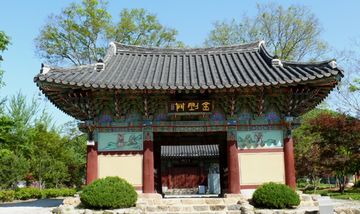"완주 송광사 금강문"의 두 판 사이의 차이
(→영문) |
(→영문) |
||
| 38번째 줄: | 38번째 줄: | ||
'''Geumgangmun Gate of Songgwangsa Temple, Wanju''' | '''Geumgangmun Gate of Songgwangsa Temple, Wanju''' | ||
| − | Geumgangmun | + | Geumgangmun ("Gate of the Vajra") is a gate that enshrines images of wrathful guardians and is typically found along the entrance path to a Buddhist temple. Wrathful guardians are protectors of the Buddhist teachings who wield the vajra, an legendary weapon said to be indestructable. |
| − | Geumgangmun Gate of Songgwangsa Temple was | + | Geumgangmun Gate of Songgwangsa Temple was built in 1665. While most temple gates have gable roofs, this gate features a hip-and-gable roof, which accentuates its stately appearance and well-proportioned facade. The roof is supported by intricate brackets installed both atop the pillars and above the lintels. Inside, the building features an open ceiling with exposed rafters. The gate holds great artistic and academic value as an example of high-level woodwork craftsmanship and traditional architecture. |
| − | + | Enshrined inside the gate are the wrathful guardians Guhyapada and Narayana, depicted on the right and left, respectively. Guhyapada is accompanied by Child Manjusri riding a lion, while Narayana is accompanied by Child Samantabhadra riding an elephant. | |
===영문 해설 내용=== | ===영문 해설 내용=== | ||
2023년 11월 14일 (화) 10:51 판
| 송광사 금강문 |
|
 송광사 금강문, 국가문화유산포털, 문화재청. |
|
| 대표명칭 | 송광사 금강문 |
|---|---|
| 한자 | 松廣寺 金剛門 |
| 주소 | 전라북도 완주군 소양면 대흥리 569번지 |
| 지정번호 | 전라북도 유형문화재 제173호 |
| 지정일 | 1999년 7월 9일 |
| 분류 | 유적건조물/종교신앙/불교/문 |
| 시대 | 조선시대 |
| 수량/면적 | 1동 |
| 웹사이트 | 송광사 금강문, 국가문화유산포털, 문화재청. |
해설문
국문
송광사 금강문은 불법을 수호하는 금강역사상을 모셔 사찰의 주 공간인 대웅전으로 가는 길목을 지키는 역할을 한다.
조선 현종 6년(1665)에 창건된 송광사 금강문은 규모가 앞면 3칸, 옆면 2칸이고, 지붕선이 여덟 팔(八) 자 모양의 팔작지붕 건물이다. 일반적으로 금강문이 사람 인(人) 자 모양의 맞배지붕을 사용하는 것과 달리, 송광사 금강문은 팔작지붕으로 크고 웅장한 느낌을 주며 전체적으로 균형 잡힌 외관을 지니고 있다.
지붕을 받치기 위한 공포는 다포 양식이고, 천장은 서까래를 그대로 노출시킨 연등천장이다. 전체적으로 조각 수법이 우수하고, 옛 건축 기술도 잘 남아 있어 예술적․학술적 가치가 높다.
건물 안 동쪽에는 사자를 탄 문수동자상과 밀적금강을, 서쪽에는 흰 코끼리를 탄 보현동자상과 나라연금강을 모셨다.
- 밀적금강: 손에 금강저를 들고 부처를 호위하는 신
- 나라연금강: 불법을 지키는 신으로, 힘의 세기가 코끼리의 백만 배나 된다고 한다.
영문
Geumgangmun Gate of Songgwangsa Temple, Wanju
Geumgangmun ("Gate of the Vajra") is a gate that enshrines images of wrathful guardians and is typically found along the entrance path to a Buddhist temple. Wrathful guardians are protectors of the Buddhist teachings who wield the vajra, an legendary weapon said to be indestructable.
Geumgangmun Gate of Songgwangsa Temple was built in 1665. While most temple gates have gable roofs, this gate features a hip-and-gable roof, which accentuates its stately appearance and well-proportioned facade. The roof is supported by intricate brackets installed both atop the pillars and above the lintels. Inside, the building features an open ceiling with exposed rafters. The gate holds great artistic and academic value as an example of high-level woodwork craftsmanship and traditional architecture.
Enshrined inside the gate are the wrathful guardians Guhyapada and Narayana, depicted on the right and left, respectively. Guhyapada is accompanied by Child Manjusri riding a lion, while Narayana is accompanied by Child Samantabhadra riding an elephant.
영문 해설 내용
금강문은 사찰의 주 공간인 대웅전 영역으로 진입하는 문으로 불법을 수호하는 금강역사상을 모신다.
송광사 금강문은 1665년에 창건되었다. 일반적으로 금강문은 맞배지붕을 사용하는데 이 건물은 팔작지붕으로 크고 웅장한 느낌을 주며 전체적으로 균형 잡힌 외관을 지니고 있다. 지붕의 무게를 받치는 공포는 기둥 위와 기둥 사이에도 설치되어 있고, 천장은 서까래를 그대로 노출시킨 연등천장이다. 전체적으로 조각 수법이 우수하고, 옛 건축 기술도 잘 남아 있어 예술적․학술적 가치가 높다.
건물 안 동쪽에는 사자를 탄 문수동자상과 밀적금강을, 서쪽에는 흰 코끼리를 탄 보현동자상과 나라연금강을 모셨다.